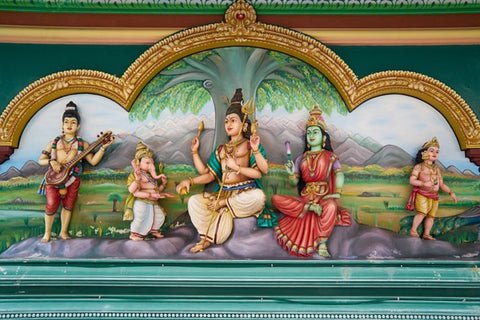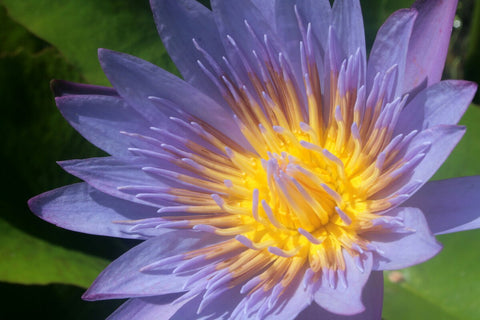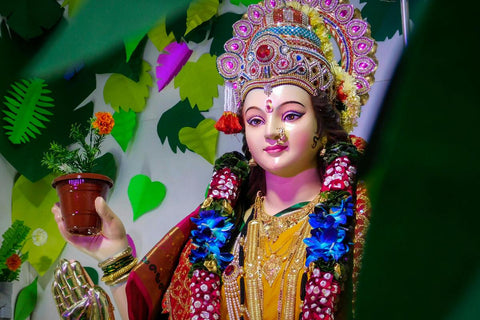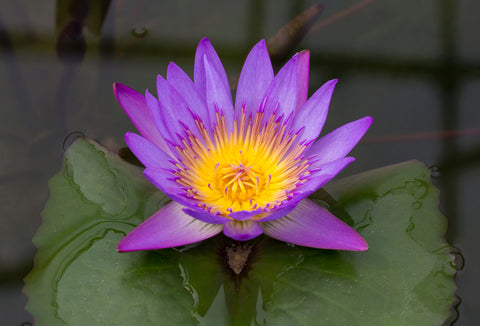
What Does The Blue Lotus Mean In Hinduism?
Share
Among the vibrant tapestry of symbols in Hinduism, the lotus flower stands out for its enduring association with purity, enlightenment, and rebirth. However, within this diverse family of blooms, the blue lotus holds a distinct and captivating presence. This essay delves into the multifaceted symbolism of the blue lotus in Hinduism, exploring its profound connection to themes of spiritual growth, wisdom, and transcendence.

The Lotus Flower in Hinduism
Origins and Significance
The lotus flower (Padma in Sanskrit) occupies a unique and prominent position in the vast tapestry of Hindu culture and spirituality. Its symbolic significance can be traced back to the earliest Hindu texts, including the Vedas, the ancient scriptures composed between 1500 BCE and 900 BCE. In the Rigveda, the oldest Veda, the lotus flower is mentioned as a symbol of beauty, prosperity, and the divine feminine.
The lotus flower also plays a crucial role in Hindu mythology. According to various creation myths, the lotus flower emerges from the navel of Lord Vishnu, the preserver god, symbolizing the birth of the universe. In another version, the creator god, Brahma, is said to be born from a lotus flower that grows from Vishnu's navel. These stories highlight the association of the lotus flower with creation and the divine.
In Hindu art, the lotus flower is depicted extensively in various forms. Deities like Lakshmi, the goddess of wealth and prosperity, Saraswati, the goddess of knowledge and learning, and Brahma are often shown seated on lotus thrones, signifying their divine status and association with purity and enlightenment. Additionally, the lotus flower motif is frequently used in temple architecture, mandalas (sacred diagrams), and yantras (mystic diagrams).
Varieties of Lotus Flowers
While the lotus flower holds a general symbolic significance in Hinduism, different colored varieties carry specific meanings.
- White Lotus: The white lotus, also known as the moon lotus, is considered the purest and most sacred of all lotus flowers. It symbolizes purity, enlightenment, spiritual growth, and detachment from worldly desires. This is why white lotus flowers are often offered to deities and used in meditation practices focusing on achieving inner peace and clarity.
- Pink Lotus: The pink lotus, also known as the rose lotus, is associated with love, compassion, and devotion. It is linked to the goddess Lakshmi and symbolizes divine grace, beauty, and prosperity. Pink lotus flowers are often offered during pujas (worship rituals) dedicated to Lakshmi and can represent blessings for abundance and well-being.
- Red Lotus: The red lotus, also known as the fire lotus, embodies passion, energy, and creative power. It is associated with the goddess Durga, the fierce aspect of the divine feminine, and symbolizes strength, determination, and overcoming challenges. Red lotus flowers are sometimes used in rituals invoking Durga's blessings for conquering internal and external obstacles.
The Blue Lotus
While all lotus flowers hold significance, the blue lotus holds a distinct and unique meaning within the Hindu context. Unlike the readily available white, pink, and red varieties, the blue lotus is rarer and considered more mystical. This rarity adds to its symbolic weight, often associated with:
- Wisdom and Knowledge: The blue lotus, with its vibrant color and association with the sky, is linked to the pursuit of knowledge and the expansion of consciousness. It is often linked to Saraswati, the goddess of learning, and symbolizes the acquisition of wisdom, intellectual pursuits, and the path to enlightenment.
- Transcendence and Spiritual Growth: The blue lotus, growing in muddy water yet remaining untouched, represents the potential for spiritual growth despite worldly challenges. It symbolizes the ability to rise above the limitations of the material world and connect with the divine. This association makes the blue lotus a powerful symbol for spiritual seekers and practitioners on the path of self-realization and liberation (moksha).

The Blue Lotus: Symbolism and Interpretations
Wisdom and Knowledge
The blue lotus, with its vibrant blue color often likened to the vastness of the sky, transcends its physical beauty. In Hinduism, it blossoms into a powerful symbol, embodying the very essence of the pursuit of knowledge and the expansion of consciousness. This association is deeply rooted in various aspects of Hindu mythology and symbolism. The blue lotus becomes a bridge, connecting the seeker's yearning for wisdom with the vast potential of the universe. Ultimately, it serves as a powerful visual reminder of the path towards enlightenment, a path paved with dedication, perseverance, and the unwavering quest for truth.
Connection to Saraswati
The primary deity associated with the blue lotus is Saraswati, the goddess of knowledge, learning, music, arts, and creativity. She is often depicted holding a book and a veena (a stringed instrument) in her hands, while seated on a lotus throne, frequently made of the blue lotus. This imagery symbolizes the connection between the blue lotus and the pursuit of knowledge, as Saraswati represents the path to acquiring and sharing wisdom through various forms of learning and artistic expression.
The Pursuit of Truth
The blue lotus, rising from the muddy waters with its pristine beauty, embodies the unwavering pursuit of truth even amidst the world's complexities. Its vibrant blue color, mirroring the vastness of the sky and the depths of the ocean, symbolizes the limitless nature of knowledge. Just as the sky suggests endless possibilities, so too does the blue lotus signify the never-ending journey towards truth's illumination. This captivating flower serves as a potent reminder that true wisdom lies not in achieving a final destination, but in the continuous exploration and expansion of one's understanding.
The Path to Enlightenment
Within the Hindu framework, the ultimate goal is to achieve moksha (liberation) from the cycle of rebirth (samsara). The blue lotus, through its association with knowledge and wisdom, signifies the path towards enlightenment and liberation. By gaining knowledge and understanding the true nature of reality, one can break free from the illusion of the material world and achieve spiritual liberation.
Transcendence and Spiritual Growth
Another prominent interpretation of the blue lotus symbol is its connection to transcendence and spiritual growth. The lotus flower, with its delicate petals rising above muddy waters, represents the potential for spiritual growth even amidst challenging circumstances. The mud symbolizes the material world with its attachments and desires, while the lotus flower signifies the ability to rise above these worldly limitations and focus on attaining spiritual purity.
The Lotus Flower as a Symbol of Resilience
The lotus flower's ability to thrive in muddy waters embodies the concept of resilience in the face of challenges. Despite its beautiful and delicate appearance, the lotus flower demonstrates remarkable strength and perseverance in its ability to grow and blossom in an environment filled with obstacles. This characteristic resonates with the spiritual journey, as it emphasizes the importance of overcoming challenges and remaining steadfast on the path towards self-realization.
Other Interpretations
- Victory of the Spirit: The blue lotus, with its vibrant color and association with the vastness of the sky, can also symbolize the victory of the spirit over worldly attachments and limitations. This interpretation emphasizes the human spirit's inherent resilience and potential to overcome challenges and achieve self-mastery, even amidst the complexities and limitations of the material world.
-
Connection to the Divine:
The blue lotus, often shrouded in an air of mystery due to its rarity and elusive nature, also symbolizes a connection to the divine. This interpretation suggests that the dedicated pursuit of knowledge and spiritual growth, mirrored by the lotus's resilience in harsh environments, opens a pathway for individuals to cultivate a closer and more profound connection with the divine realm.
- Mystic Knowledge and Esoteric Practices: In certain Hindu traditions, particularly those associated with Tantra, the blue lotus is associated with mystic knowledge and esoteric practices. This interpretation connects the blue lotus to the exploration of hidden dimensions of reality and the pursuit of self-knowledge through practices like meditation and rituals.
It is important to note that these interpretations of the blue lotus are not mutually exclusive and can often overlap and complement each other. The specific meaning of the blue lotus may vary depending on the context and individual understanding within the vast and diverse landscape of Hindu traditions.

The Blue Lotus in Hindu Practices and Rituals
The blue lotus, with its rich symbolism, transcends the realm of theory and finds tangible expressions in various Hindu practices and rituals.
Offerings to Deities
- Saraswati Puja: The blue lotus holds a special place in the worship of Saraswati, the goddess of knowledge and learning. During Saraswati Puja, typically celebrated during the festival of Vasant Panchami, blue lotus flowers are often offered to the deity. This offering symbolizes the seeker's dedication to learning and their desire to receive the blessings of knowledge and wisdom from Saraswati.
- Other Deities: While primarily associated with Saraswati, the goddess of knowledge and learning, blue lotus flowers can also be offered to other deities in specific contexts. For instance, offerings to Vishnu, the preserver god, may incorporate blue lotus flowers, symbolizing both his role in creation and the potential for spiritual growth that blossoms within his divine energy.
Meditation Practices-h3
The blue lotus, with its symbolic connection to focus and clarity, plays a role in various meditation practices.
- Visualization: Meditators may visualize a blue lotus flower blooming within their minds, focusing on its pristine beauty and its connection to knowledge and spiritual growth. This visualization can help cultivate a state of calmness and enhance focus during meditation.
- Symbolic Associations: The qualities and symbolism associated with the blue lotus, like resilience, overcoming challenges, and attaining purity, can serve as guiding principles during meditation. By reflecting upon these symbolic associations, practitioners can cultivate the corresponding qualities within themselves.
Symbolic Representations
The blue lotus motif finds its way into sacred art forms like mandalas and yantras. These visual representations hold deep symbolic meaning within the Hindu tradition.
- Mandalas: In mandalas, the blue lotus flower may be depicted as a central element or as part of a larger design. Its presence can symbolize the central focus of the mandala practice, which could be attaining enlightenment, seeking knowledge, or cultivating specific spiritual qualities.
- Yantras: Yantras, which are geometric diagrams, may also incorporate the blue lotus symbol. The specific meaning of the blue lotus within a yantra will depend on the yantra's purpose and the associated deity. However, it generally signifies qualities like knowledge, purity, and spiritual growth.
These practices and rituals highlight how the blue lotus serves as more than just a symbolic representation. Its presence in these rituals acts as a reminder of the spiritual aspirations and the qualities one strives to cultivate on the path towards self-realization.

The Blue Lotus in Contemporary Hinduism
The blue lotus, despite its ancient roots, continues to hold significant meaning and relevance in contemporary Hinduism. Its enduring message of spiritual growth and wisdom resonates with modern Hindus in various ways.
Modern Expressions
- Art and Culture: The blue lotus continues to inspire artists, appearing in various forms of modern art, including paintings, sculptures, and digital art. These artistic expressions depict the blue lotus in contemporary styles while retaining its symbolic significance.
- Cultural Events and Festivals: The blue lotus can be seen incorporated into cultural events and festivals, such as decorations during religious ceremonies or symbolic representations in traditional dance performances. This continued use underscores the cultural significance and enduring appeal of the blue lotus symbol.
Spiritual Practices
- Spiritual discourses and teachings often reference the blue lotus to illustrate concepts like the pursuit of knowledge, overcoming worldly attachments, and achieving spiritual growth. This helps contemporary practitioners connect with the ancient wisdom embodied by the symbol.
- Personal meditation practices still incorporate the blue lotus flower through visualization, contemplation of its symbolism, or incorporating its image as a focus point. This practice allows individuals to connect with the deeper meanings associated with the blue lotus on a personal level.
Enduring Message
Despite the changes and evolution of contemporary society, the blue lotus continues to serve as a potent symbol reminding individuals of their potential for spiritual growth, wisdom, and transcendence. It acts as a bridge connecting ancient Hindu tradition with contemporary spiritual seekers and practitioners, offering timeless guidance on their journey towards self-realization.
Conclusion
The blue lotus, with its vibrant color and unique characteristics, occupies a significant and multifaceted space within the vast tapestry of Hindu culture and symbolism. Its historical presence in ancient scriptures, mythology, and art speaks volumes about its enduring significance. While various colored lotus flowers hold individual meanings, the blue lotus stands out with its distinct association with wisdom, knowledge, and transcendence. It represents the pursuit of truth, the potential for spiritual growth despite challenges, and the path towards achieving liberation. This rich symbolism finds expressions in Hindu practices and rituals, from offerings to deities to symbolic depictions in mandalas and yantras. Moreover, the blue lotus continues to hold relevance in contemporary Hinduism, inspiring artists, gracing cultural events, and guiding spiritual seekers on their journeys. Ultimately, the enduring power of the blue lotus lies in its ability to connect individuals across time and space, reminding them of the potential for spiritual growth and the pursuit of wisdom that lies within each of us.

